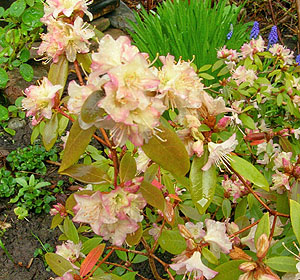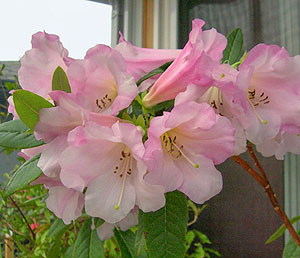Article Copied from the American Rhododendron Society Blog
Print date: 5/9/2025
Two Lovely Ladies
26 April 2015 @ 12:48 | Posted by Norma
Two of my favourite rhododendrons were named after two ladies - Mary Fleming and the Countess of Haddington. I have no idea what the namesakes of these varieties were like in life, but if I had to guess about them based on the plants bearing their names, then they both must have been lovely ladies, but altogether different.
I picture Mary Fleming as having been a dainty, petite lady who had a spine of steel. She must have been very pretty too. Rhododendron 'Mary Fleming' is such a good "do-er" in the garden. My own plant is in a fairly tough spot that gets full sun for most of the day and is often very dry in the summer. However, Mary Fleming grows well there and rewards me with lots of small pinky-yellow flowers every March. For me, it's one of my most reliable early bloomers and the flowers last through light frosts.
The plant is attractive throughout the year with small leaves that often take on a reddish hue in the winter. It stays fairly small - about 2' in ten years, and that's about the height of mine, but I have seen older plants reach about 5'. It's a hybrid of two lovely species, racemosum and keiski. While my plant is in the ground, Mary Fleming also makes a good potted plant due to its small stature.

The Countess of Haddington is an old variety, (1862), so presumably, was named after the real Countess of the day. It was a cross of ciliatum by dalhousiae. For those lucky enough to garden in warmer climates than mine, I suspect you can manage this one easily out of doors, but here in the Pacific Northwest, the Countess requires effort. I guess that since she's an aristocrat, she expects special treatment.
I grow my 'Countess of Haddington' in a 5 gallon pot. During the summer months she lazes around under the shade of an old apple tree where she gets some protection from the heat of the day and from full sun. I use a slow-release fertilizer treatment three times a year, and the Countess gets lots of water as the pot dries out quickly. I may have to break down and re-pot this plant this summer, but if I do, it will go into as light weight a pot as I can find because I do move the pot around frequently in winter. I occasionally pinch back some of the new shoots to keep the plant a manageable size and maintain some fullness. However, even after 6 years, the plant is a very manageable 4' tall, presumably due to its ciliatum heritage.

Since the Countess of Haddington is tender here, as soon as the temperature drops to near freezing, the plant gets moved to a sheltered area near the house where it spends much of the winter. I like to leave my tender rhodies outside as much as possible in the winter, but I pay close attention to temperature forecasts and my secret to growing them is to be ready to move pots into a frost-free area whenever necessary. The Countess of Haddington is only hardy to about 20°F, so I'm prepared to pop it and all my other tender rhodies under my enclosed deck anytime the weather forecast indicates the temperature may drop to more than just a few degrees of frost. There aren't any windows under the deck so the plants remain in the dark during cold weather. During cold weather snaps, I have left them in this location for up to three weeks at a time, but they manage just fine even though there's no light. Once the cold is past though, they get moved back outside to their sheltered spot. I take care to make sure The Countess and her friends are watered on an as needed basis throughout the winter. It is surprising how fast they can dry out, even if it's pouring rain.
As soon as I see the flower buds opening, usually mid to late February, the Countess is moved into my sunroom where I'm rewarded with large, trumpet-like flowers of very pale pink. The fragrance is also wonderful and the plant perfumes the entire house. Since the sunroom is fairly cool, the plant stays in flower for almost a month which makes my efforts worthwhile. So, while Mary Fleming is a tough plant and the Countess of Haddington is a tender aristocrat, they're both lovely ladies, and I enjoy their company.